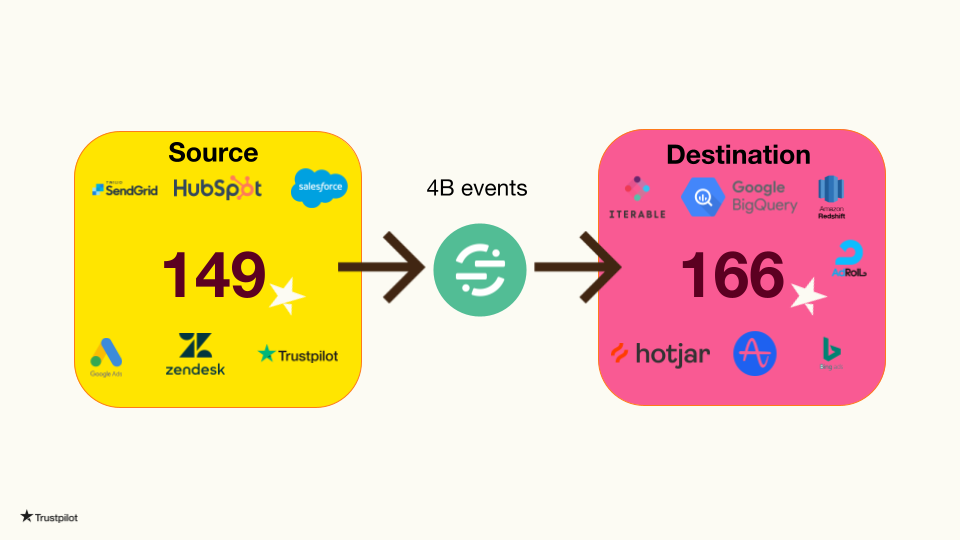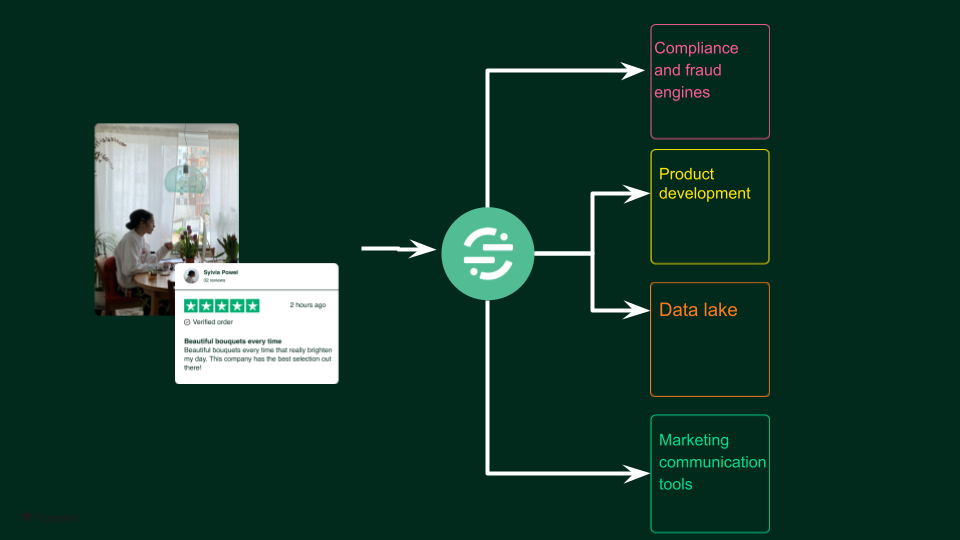Table of Contents
Trustpilot, the leading online platform for consumer reviews, aims to become the most recognized symbol of trust on the internet. Since its inception in 2007, Trustpilot has grown to host over 213 million reviews — a number that is growing by more than one review every second. With such a large volume of reviews, Trustpilot's success relies on the trustworthiness of its services and the efficiency and integrity of its data.
As Angela Timofte, VP of Engineering at Trustpilot says “since 2007 we’ve grown to house over 213M reviews, but growth hasn’t been linear, in 2022 alone we received over 46 million reviews — a 27% increase compared to the previous year…and these numbers are constantly increasing while their importance is becoming even more critical. With the large volume of reviews, our service must be trustworthy to succeed”. So, to achieve this they turned to Twilio Segment, with the implementation starting when both companies were in their startup phase, many moons ago.
Segment’s scalability and reliability meant that as Trustpilot grew they were able to focus on their vision, instead of using valuable resources to manage data transfer. This significantly reduced the need for a large data engineering team, since Segment collects and unifies data, automatically. Segment has also been instrumental in helping Trustpilot foster a data-driven culture by making data accessible and accurate.
Working towards becoming the universal symbol of trust on the internet, with a modern data foundation
In order to uphold the integrity of Trustpilot’s platform, maintaining a data-driven approach across all teams is crucial. By leveraging Segment Connections to collect and unify data, Trustpilot is able to detect reviews that don’t reflect a genuine experience. This constant evaluation and evolution of their approach helps Trustpilot maintain the credibility of its platform amidst rapid growth. For instance, when a customer shares a review on Trustpilot, the platform collects data using Segment. This data serves multiple purposes, such as validating the authenticity of the customer’s profile and checking for suspicious behavior or data patterns, through compliance and fraud engines. “Implementing Segment at Trustpilot has been instrumental in democratising our data. By enabling us to collect, manage, and govern our data, Segment has ensured data accuracy and reliability, which has saved us valuable time and resources. The tool's ability to scale with our growth has also allowed us to deliver personalised experiences at scale, which is essential given the sheer volume of reviews and visitors we receive” says Angela Timofte, VP of Engineering at Trustpilot.
Data at the core of Trustpilot's mission
With 149 sources, 166 destinations, and an average of 4 billion events flowing through Segment monthly, Segment plays a crucial role in Trustpilot's data strategy. If Trustpilot were not using Segment, the data engineering team would have to create and maintain integrations, manage data governance, and ensure data integrity. This would take valuable time and resources away from focusing on Trustpilot's core vision of platform trust. In addition, Segment powers Trustpilot’s analytics engine that they package up for their customers to give them insight into user experience and sentiment scores, based on an aggregated analysis of reviews.

Leverage verified reviews for customer insights
Enabling seamless collaboration and informed decision-making across teams, Trustpilot leverages Segment to break down data silos and foster a data-driven culture. With Segment's user-friendly design, Trustpilot empowers teams spanning marketing, data science, product management, engineering, data analysis, and customer support with easy access to valuable data. The journey begins when a user submits a review on Trustpilot, triggering a series of actions that unlock the full potential of this data.
First, the review data seamlessly flows into compliance and fraud engines, ensuring reviews reflect a genuine experience. Once verified, the data is seamlessly transmitted to marketing tools, unveiling valuable insights into customer behavior, preferences, and needs. Armed with this comprehensive understanding, Trustpilot crafts targeted marketing campaigns tailored to each customer, while also utilizing the holistic customer view to send personalized surveys and recommendations based on their unique behaviors.
The journey of Trustpilot's data doesn't end there. It continues to fuel product development, as the data is piped into analytics tools such as Omniture and Mixpanel. These tools enable the product team to track the impact of product changes, identify trends, establish a shared language across stakeholders, and make data-driven decisions, eliminating guesswork and relying on concrete insights. Finally, Trustpilot securely stores this valuable data in their centralized Google Cloud data lake, where it serves as a foundation for further analysis and the creation of data science models, ensuring continuous evolution and enhancement of their platform.

What’s next?
Trustpilot is looking to level up their Segment environment and is considering investing in Twilio Engage (a powerful multichannel marketing platform). This will help the marketing team activate the data collected through Segment with audience and campaign journey creation. They’re also exploring the possibility of enriching customer data from their warehouse, with Profiles Sync (Segment's comprehensive customer profiles synced to your data warehouse automatically).
Interested in hearing more about how Segment can help you?
Connect with the team to learn how 25,000+ companies use Segment's extensible, scalable platform to turn customer data into revenue-generating experiences.